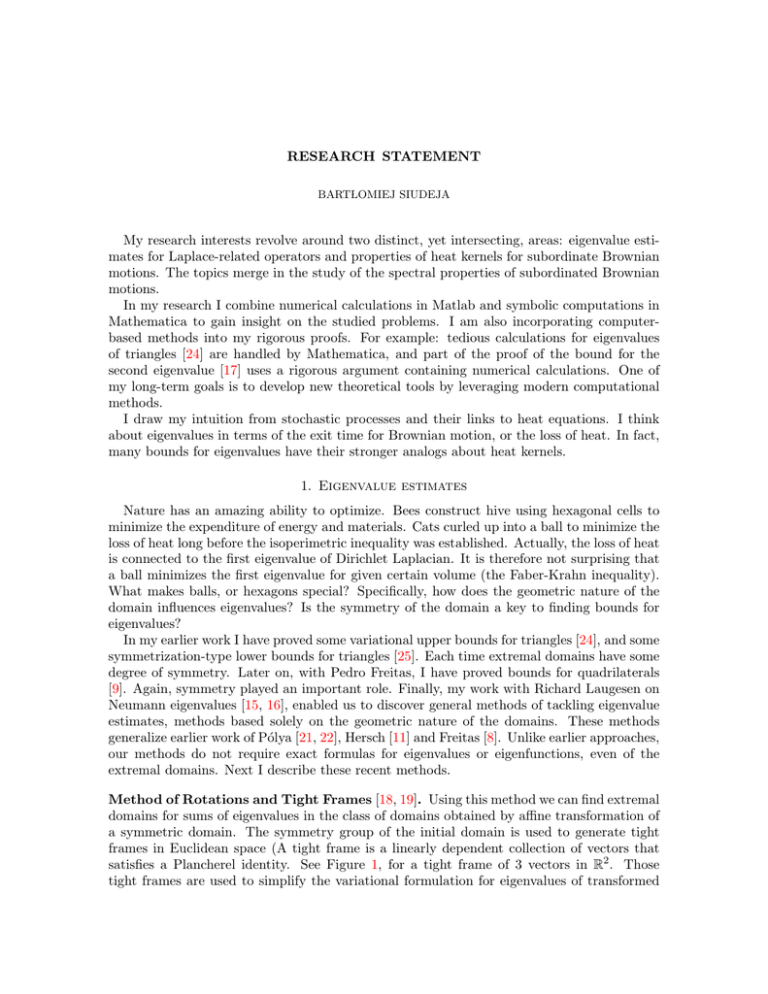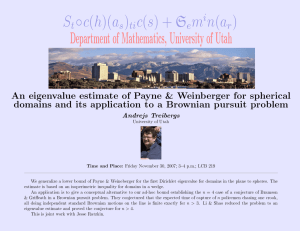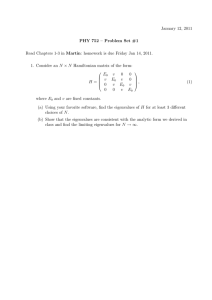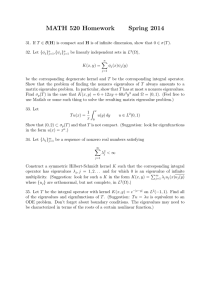RESEARCH STATEMENT My research interests revolve around two
advertisement

RESEARCH STATEMENT BARTLOMIEJ SIUDEJA My research interests revolve around two distinct, yet intersecting, areas: eigenvalue estimates for Laplace-related operators and properties of heat kernels for subordinate Brownian motions. The topics merge in the study of the spectral properties of subordinated Brownian motions. In my research I combine numerical calculations in Matlab and symbolic computations in Mathematica to gain insight on the studied problems. I am also incorporating computerbased methods into my rigorous proofs. For example: tedious calculations for eigenvalues of triangles [24] are handled by Mathematica, and part of the proof of the bound for the second eigenvalue [17] uses a rigorous argument containing numerical calculations. One of my long-term goals is to develop new theoretical tools by leveraging modern computational methods. I draw my intuition from stochastic processes and their links to heat equations. I think about eigenvalues in terms of the exit time for Brownian motion, or the loss of heat. In fact, many bounds for eigenvalues have their stronger analogs about heat kernels. 1. Eigenvalue estimates Nature has an amazing ability to optimize. Bees construct hive using hexagonal cells to minimize the expenditure of energy and materials. Cats curled up into a ball to minimize the loss of heat long before the isoperimetric inequality was established. Actually, the loss of heat is connected to the first eigenvalue of Dirichlet Laplacian. It is therefore not surprising that a ball minimizes the first eigenvalue for given certain volume (the Faber-Krahn inequality). What makes balls, or hexagons special? Specifically, how does the geometric nature of the domain influences eigenvalues? Is the symmetry of the domain a key to finding bounds for eigenvalues? In my earlier work I have proved some variational upper bounds for triangles [24], and some symmetrization-type lower bounds for triangles [25]. Each time extremal domains have some degree of symmetry. Later on, with Pedro Freitas, I have proved bounds for quadrilaterals [9]. Again, symmetry played an important role. Finally, my work with Richard Laugesen on Neumann eigenvalues [15, 16], enabled us to discover general methods of tackling eigenvalue estimates, methods based solely on the geometric nature of the domains. These methods generalize earlier work of Pólya [21, 22], Hersch [11] and Freitas [8]. Unlike earlier approaches, our methods do not require exact formulas for eigenvalues or eigenfunctions, even of the extremal domains. Next I describe these recent methods. Method of Rotations and Tight Frames [18, 19]. Using this method we can find extremal domains for sums of eigenvalues in the class of domains obtained by affine transformation of a symmetric domain. The symmetry group of the initial domain is used to generate tight frames in Euclidean space (A tight frame is a linearly dependent collection of vectors that satisfies a Plancherel identity. See Figure 1, for a tight frame of 3 vectors in R2 . Those tight frames are used to simplify the variational formulation for eigenvalues of transformed 2 BARTLOMIEJ SIUDEJA domains. Thus, we mix applied harmonic analysis with the theory of group representations (to find tight frames) to obtain sharp bounds for eigenvalues. The resulting bounds use area and the moment of inertia as scaling factors for eigenvalues, and the extremal domain is shown to be symmetric for all of Dirichlet, Neumann and Robin boundary conditions. A strength of the method is that it applies also to higher dimensions. 3 2x y x Figure 1. The “Mercedes–Benz” tight frame (3-fold rotational symmetry) in the plane. The reconstructed vector equals 3/2 of the original one. Method of the Unknown Trial Function [17]. Using this method we get lower bounds for eigenvalues in a one or two parameter class of domains. Our approach is to “interpolate” between two or three simple cases to get some information about intermediate domains. We use convex optimization and rigorous numerical calculations on the chosen special domains to get general bounds for the whole class. The method does not require exact eigenfunctions even in the special cases. We proved that the sums of Dirichlet eigenvalues of triangles, scaled with diameter, are minimal for equilaterals. The same is true for the second eigenvalue alone. F+ E F− Figure 2. Linear maps to an arbitrary triangle, from more familiar domains: the equilateral triangle E and two right triangles F± . Future directions. The new methods exploit the geometric nature of the domain, and not the specific form of the operator. This opens up a huge area of applications to other physics-related eigenvalue problems. Instead of a vibrating membrane (the Laplacian), I want to consider a vibrating plate (the biLaplacian). My methods should further adapt to give sharp geometric bounds for magnetic and elastic energies and eigenvalues of nonlinear diffusions. The challenges are numerous: plates are related to a fourth order operator, elastic eigenfunctions are vector valued, the magnetic Laplacian has complex eigenwaves. Classical methods fail in most of these cases. My methods, together with computer-based techniques, provide a way to break the barrier. In a long perspective, I hope to gain enough insight on the mentioned cases, to prove general bounds for convex domains. RESEARCH STATEMENT 3 2. Heat kernels The energy dynamics of the environment are crucial to the existence of life. A fundamental aspect of this is how the heat is distributed in a given domain. A radiator in the corner of a room can provide warmth to the whole area, but this diffusion is not an instantaneous process. This phenomenon is governed by the heat equation and ultimately by the heat kernel. I am most interested in sharp heat kernel estimates on domains, and problems that can be tackled using such estimates. Probabilistically, heat kernels are transition densities for a process. While it is possible to write down exact distributions for some free processes, it is virtually impossible, even in the Brownian case, to explicitly write transition densities for killed processes. My work on heat kernels has concentrated on two subjects. Monotonicity of the Neumann heat kernel [4]. We showed that the length of the reflected Brownian motion in a ball has nondecreasing diagonal of the heat kernel in all dimensions except d = 2. This result relates to a conjecture of Laugesen and Morpurgo [14] about monotonicity of the Neumann heat kernel on a ball. This conjecture was recently proved by Pascu and Gageonea [20]. p(t, x, −x) = ct e−2x 2 /t p(t, x, x) = ct x 0 Figure 3. Reflected Brownian motion on a half line. The Neumann heat kernel is a sum of two free transitions and it is clearly increasing toward the boundary (0). We proved the much harder case of the radial process on the ball in higher dimensions. Sharp heat kernel estimates for symmetric stable processes, and relativistic processes [23]. I have found sharp upper bounds on the decay of the heat kernels near the boundary of a convex domain with simultaneous comparability to the free kernel. As an application, I have found conditions under which relativistic Schrödinger semigroups are intrinsically ultracontractive [13]. I have also discovered finiteness conditions for moments of exit times for symmetric stable processes from unbounded domains [23]. In particular, if a domain is obtained by a revolution of an increasing function, the finiteness of a moment of the exit time is equivalent to evaluation of a certain integral involving that function. This work generalizes results of Bogdan and Bañuelos [1]. α/2 δD (x) x |x − y | −d− α y α/2 D δD (y) Figure 4. Heat kernel pD (t, x, y) of a domain D can be estimated using just three factors: distances to the boundary and the distance between the points. 4 BARTLOMIEJ SIUDEJA Future directions. Brownian motion was the tool of choice for financial mathematics and mathematical physics for a long time. Yet many models are too rough to use nice continuous processes. Recent developments on subordinate Brownian motions opened up a possibility for real life applications. In fact stable processes are already used in computational finance. I want to contribute to this phase change by studying finiteness of the expectation of the exit time for a wide class of processes. I will also study Schrödinger semigroup properties for subordinate Brownian motions. The monotonicity of the Neumann heat kernel is in turn related to the hot-spots conjecture of M. van den Berg [2, 6, 7], stating that the minimum of the first non-constant Neumann eigenfunction is obtained on the boundary. Physically, this means that given an insulated plate, the hottest spot will move with time toward the boundary. This conjecture is still open for convex domains, indeed even for acute triangles. For obtuse triangles it was proved by Bañuelos and Burdzy [2]. Even though it can be stated using partial differential equations, the most promising partial results were obtained using probabilistic methods related to my earlier research. I will try to solve this conjecture for convex domains. 3. Spectral problems for stochastic processes M. Kac asked [12] if one can hear the shape of a drum. Now, we know that this is not always possible [10]. However, one can get a lot of information about a domain from the spectrum of the Laplacian. But, what can one say about a domain by studying other operators? For example fractional diffusions. This question brings together my two areas of interest. Asymptotics of the trace of the heat kernel of killed symmetric stable processes [5]. We establish the first two terms of the asymptotics of the trace on Lipschitz domains. This generalized the work of my coauthors on smooth domains [3]. The result resembles the Brownian case, with area and perimeter in the first two terms. However, the presence of perimeter is surprising, since the process cannot see the boundary: it always jumps out on exiting. The methods used in this paper involve precise heat kernel estimates with detailed estimates on jumps of the process (see Figure 4). Eigenvalue estimates for subordinate Brownian motion [26]. The results involve moment of inertia as scaling factors just like in the classical case. Even though Rayleigh quotient for the operators are very different from classical energy functionals, the form of a bound includes Laplace eigenvalues as a special case of 2-stable generators. Therefore the result generalizes my earlier work on Laplace eigenvalues. The Method of Rotations and Tight Frames (see Figure 1) in the frequency domain is required to obtain the result. Future directions. Asymptotics of the trace of the heat kernel implies the first order Weyl asymptotics for eigenvalues of the generator. In the Brownian case the second term is known, but it is yet to be determined for stable processes and other subordinated Brownian motions. To obtain this term, one cannot use standard wave equation related methods, due to a nonlocal character of the generator of a process. I would like to investigate the “fractional” wave equation to find the second term of the asymptotics. I will also investigate trace asymptotics for more general processes. I will start with a relativistic process, to gain some insight on possible results for general subordinate Brownian motions. Finally, I am working on sharp geometric bounds for eigenvalues of generators of subordinate Brownian motions. I am applying the Method of Rotations of Tight Frames to probabilistically defined operators. Again, the sharp results will be obtained even though eigenvalues are not explicitly computable, even in the case of a ball. RESEARCH STATEMENT 5 References [1] R. Bañuelos and K. Bogdan, Symmetric stable processes in parabola-shaped regions, Proc. Amer. Math. Soc. 133 (2005), no. 12, 3581–3587 (electronic). MR2163593 [2] R. Bañuelos and K. Burdzy, On the “hot spots” conjecture of J. Rauch, J. Funct. Anal. 164 (1999), no. 1, 1–33. MR1694534 [3] R. Bañuelos and T. Kulczycki, Trace estimates for stable processes, Probab. Theory Related Fields 142 (2008), no. 3-4, 313–338. MR2438694 [4] R. Bañuelos, T. Kulczycki and B. Siudeja, Neumann Bessel heat kernel monotonicity, Potential Anal. 30 (2009), no. 1, 65–83. MR2465712 [5] R. Bañuelos, T. Kulczycki and B. Siudeja, On the trace of symmetric stable processes on Lipschitz domains, J. Funct. Anal. 257 (2009), no. 10, 3329–3352. MR2568694 [6] R. Bañuelos, M. Pang and M. Pascu, Brownian motion with killing and reflection and the “hot-spots” problem, Probab. Theory Related Fields 130 (2004), no. 1, 56–68. MR2092873 [7] R. F. Bass and K. Burdzy, Fiber Brownian motion and the “hot spots” problem, Duke Math. J. 105 (2000), no. 1, 25–58. MR1788041 [8] P. Freitas, Upper and lower bounds for the first Dirichlet eigenvalue of a triangle, Proc. Amer. Math. Soc. 134 (2006), no. 7, 2083–2089 (electronic). MR2215778 [9] P. Freitas and B. Siudeja, Bounds for the first Dirichlet eigenvalue of triangles and quadrilaterals, ESAIM Control Optim. Calc. Var. 16 (2010), no. 3, 648–676. MR2674631 [10] C. Gordon, D. Webb and S. Wolpert, Isospectral plane domains and surfaces via Riemannian orbifolds, Invent. Math. 110 (1992), no. 1, 1–22. MR1181812 [11] J. Hersch, Contraintes rectilignes parallèles et valeurs propres de membranes vibrantes, Z. Angew. Math. Phys. 17 (1966), 457–460. MR0208192 [12] M. Kac, Can one hear the shape of a drum?, Amer. Math. Monthly 73 (1966), no. 4, part II, 1–23. MR0201237 [13] T. Kulczycki and B. Siudeja, Intrinsic ultracontractivity of the Feynman-Kac semigroup for relativistic stable processes, Trans. Amer. Math. Soc. 358 (2006), no. 11, 5025–5057 (electronic). MR2231884 [14] R. S. Laugesen and C. Morpurgo, Extremals for eigenvalues of Laplacians under conformal mapping, J. Funct. Anal. 155 (1998), no. 1, 64–108. MR1622804 [15] R. S. Laugesen and B. A. Siudeja. Maximizing Neumann fundamental tones of triangles, J. Math. Phys. 50 (2009), no. 11, 112903, 18 pp. MR2567204 [16] R. Laugesen and B. Siudeja. Minimizing Neumann fundamental tones of triangles: an optimal Poincare inequality, J. Differential Equations, 249 (2010), no. 1, 118-135. doi:10.1016/j.jde.2010.02.020 [17] R. Laugesen and B. Siudeja. Dirichlet eigenvalue sums on triangles are minimal for equilaterals. arXiv:1008.1316 [18] R. Laugesen and B. Siudeja. Sums of Laplace eigenvalues - rotationally symmetric maximizers in the plane, arXiv:1009.5326 [19] R. Laugesen and B. Siudeja. Sums of Laplace eigenvalues - rotations and tight frames in higher dimensions, in preparation. [20] M. N. Pascu, M. E. Gageonea. On a conjecture of Laugesen and Morpurgo, arXiv:0807.4726 [21] G. Polya, Sur le rôle des domaines symétriques dans le calcul de certaines grandeurs physiques, C. R. Acad. Sci. Paris 235 (1952), 1079–1081. MR0052477 [22] G. Pólya and M. Schiffer, Convexity of functionals by transplantation, J. Analyse Math. 3 (1954), 245–346. MR0066530 [23] B. Siudeja, Symmetric stable processes on unbounded domains, Potential Anal. 25 (2006), no. 4, 371–386. MR2255353 [24] B. Siudeja, Sharp bounds for eigenvalues of triangles, Michigan Math. J. 55 (2007), no. 2, 243–254. MR2369934 [25] B. Siudeja, Isoperimetric inequalities for eigenvalues of triangles, submitted. arXiv:0707.3631 [26] B. Siudeja, Rotationally symmetric maximizers for eigenvalues of generators of subordinate Brownian motions, in preparation. Department of Mathematics, University of Illinois, Urbana, IL 61801 E-mail address: siudeja@illinois.edu






